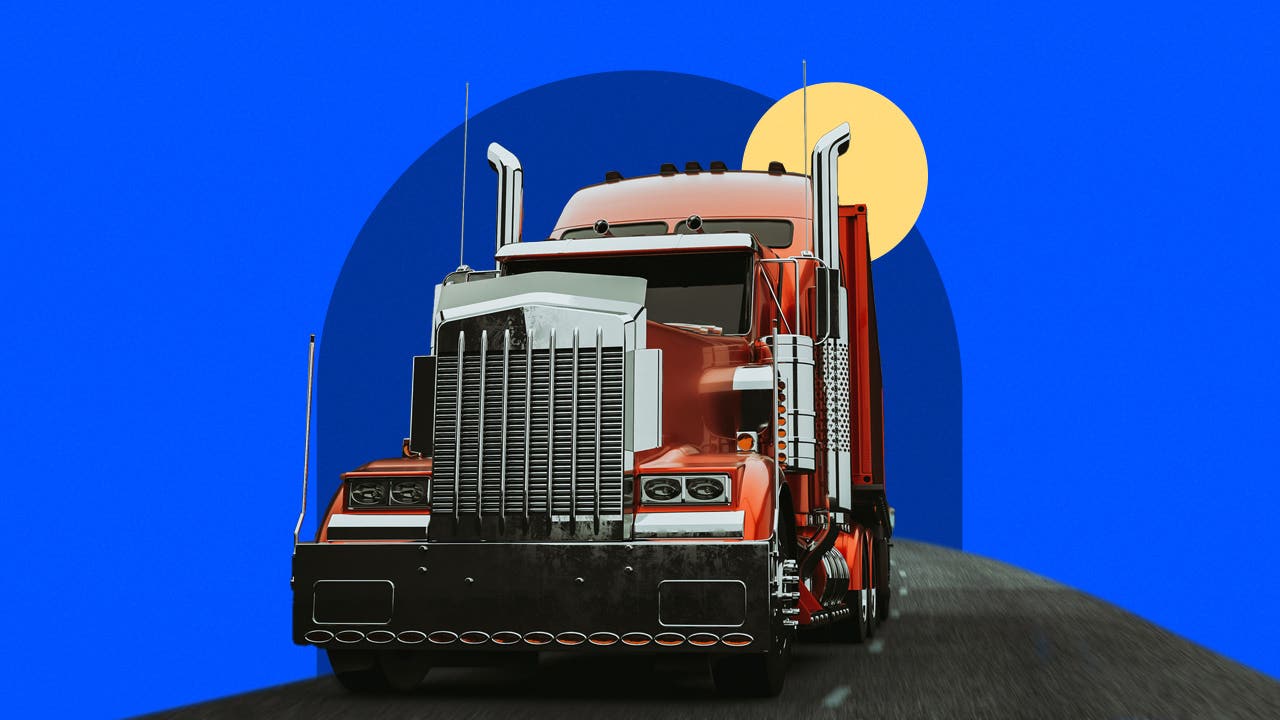
Key takeaways
- Your credit score is an important factor when applying for a semi-truck financing, and borrowers with good credit scores can expect lower loan fees and interest rates
- Most lenders require a down payment of up to 30 percent depending on your credit
- Consider both new and used trucks when financing a semi truck — new trucks offer warranties and better mileage, while used trucks may be cheaper and retain value better
Trucks play a vital role in the American shipping industry, carrying over 72 percent of the nation’s freight by weight, according to the American Trucking Association. In 2023 alone, the total value of truck-transported freight reached a staggering $18.7 trillion, showing just how profitable the trucking industry can be.
Over 3.5 million people make their living as truckers, and the Bureau of Transportation Statistics’ Freight Analysis Framework predicts annual growth of approximately 1.6 percent for shipment weight and even more rapid growth in shipment value until 2050. Whether you’re thinking about starting a career in trucking or looking to grow your existing business, a semi-truck loan could help you reach your goal. However, there are requirements you’ll need to meet to qualify for semi-truck financing.
What are the requirements to buy a semi truck?
When looking to buy a semi truck, there are semi-truck financing requirements to consider.
1. Credit score
When getting any type of loan, including an equipment loan, your credit score plays a huge role. Lenders look at your credit score to get an idea of how you’ve handled credit in the past and how likely you are to default on a loan.
The better your credit score, the easier it is to qualify for a loan. You’ll have more lenders to choose from, and those lenders will tend to offer lower loan fees and interest rates. All those things mean you’ll spend less money on your loan.
Credit scores of 670 and above are considered good, while those over 740 are very good and give you a good chance of landing the best semi-truck financing interest rates.
It’s possible to get approved for a business loan with bad credit but expect to pay higher rates. While a borrower with good credit might pay as little as 5.99 percent, someone with bad credit might pay more than 35 percent.
| Lender | Min. credit score | Details |
|---|---|---|
| Bank of America | Not disclosed, but 700 for most Bank of America business loans |
|
| National Funding | 575 |
|
| SMB Compass | 650 |
|
| Accion Opportunity Fund | 600 |
|
2. Register your business
Many semi-truck lenders will expect you to be operating a shipping business, even if you’re just an independent owner-operator contracting with other companies. This means you’ll need to officially register your business, typically by forming a limited liability company (LLC) or obtaining a Doing Business As (DBA) name. The process varies by state, so be sure to check with your local government for specific details.
You’ll also need an Employer Identification Number, which you can get for free from the IRS. Some lenders will want your business to be up and running for a certain amount of time before you apply. Minimum time-in-business requirements will vary, usually ranging from three months to two years or even longer, depending on the lender.
3. Down payment
Most borrowers will need to make a down payment — a percentage of the truck’s purchase price paid upfront — to qualify for semi-truck financing. The down payment requirement depends on your credit score.
Borrowers with good credit scores typically need to provide a 10 percent or 15 percent down payment. Some lenders like U.S. Bank offer equipment loans with no down payment requirements.
Expect to pay a down payment of 30 percent or more to reduce the lender’s risk if you need semi-truck financing for bad credit. For a $100,000 truck, that could mean providing at least $30,000 ($100,000 x 0.30 = $30,000) upfront to get a loan.
4. Vehicle
Because the truck you buy serves as collateral for your loan, the lender will want to know about the truck you’re buying when you apply for a loan. Lenders won’t approve your application unless the truck is worth enough to secure the debt.
That means you’ll have to provide info such as the truck’s model, age, mileage and condition. Many lenders have rules about what kinds of trucks they’ll make loans for.
For example, some lenders won’t finance trucks more than 10 years old or that have over 700,000 miles on them. Major issues, like a long repair history, could also scuttle a loan deal.
Should I buy a new or used semi truck?
Though lenders might be wary of used trucks, that doesn’t mean buying used is a bad idea. As with anything, there are pros and cons.
Pros of new trucks
- Warranties. Many truck sellers offer warranties on new vehicles.
- Lower maintenance costs. A new truck will need fewer repairs and maintenance than an older one, saving you money.
- Better mileage. Newer trucks tend to get better mileage than old ones, reducing gas costs.
- New technology and amenities. New trucks will have features that older trucks don’t have, such as assisted driving tools and other amenities.
Pros of used trucks
- Lower cost. Used trucks are cheaper than new ones. A new semi truck might cost $120,000 to $150,000 or more, while a used one could cost around $50,000.
- Retains value. New vehicles tend to depreciate quickly, while used trucks retain their value longer over time.
- Lower insurance rates. Used trucks are worth less, so insurers do not charge as much.
- More data. With older models, there’s more information regarding reliability and any quirks they might have.
5. CDL license
To drive a semi-truck, you’ll need a commercial driver’s license (CDL). Many lenders won’t let you borrow money to buy a truck you cannot drive, so make sure to have a CDL before applying.
6. Proof of insurance
Your truck is an expensive investment, but more importantly, to the lender, it’s the collateral for your loan. You’ll need to provide proof of insurance before you finalize your loan. In addition to any specialized insurance for a semi truck, a lender will want to know that you also meet your state’s car insurance minimum requirements.
Some of the coverage you may need includes:
- Primary liability. This pays for damage and injury your truck causes, and you’re liable for.
- Physical damage. This pays for damage to the vehicle if it gets damaged.
- Bobtail coverage. This covers things that happen while driving the truck without a trailer.
- Cargo coverage. This insures the items you are hauling against damage and loss.
What to do if you can’t afford a semi-truck loan
If you’re struggling to afford a loan for a semi-truck, there are a few alternatives to consider.
- Rent a truck. You can rent semi-trucks for a short period. This allows you to take on jobs and try to turn a profit without the large expense of buying a truck.
- Lease a truck. Leasing is a more long-term rental. It’s cheaper than buying in the short term, making it a good middle-of-the-road option if you need a truck for your company but can’t afford to finance.
- Save a down payment and build credit. While you have a leased truck, work to save some cash for a down payment. Also, do what you can to boost your credit score to secure lower rates on financing in the future. You should compare the credit score requirements to buy a semi truck to assess how much you have to improve your FICO score.
- Consider all your options. There are many ways to finance a truck, some of which might be more affordable than others. Look into dealer, bank financing and SBA loans to see if one offers a better deal.
Bottom line
Semi trucks come with a high price tag, but the right financing can make it possible to purchase one and start or expand your business. You will need to meet several semi-truck financing requirements, such as holding a valid CDL license, meeting the lender’s minimum credit score and having a specific truck in mind to purchase. Take the time to shop around and compare multiple loan options to find the most affordable semi-truck loan.
Frequently asked questions about semi-truck financing requirements
You may also like

How to get an emergency loan in 5 simple steps

How to get an RV loan without breaking the bank

What documents do you need to finance a car?



